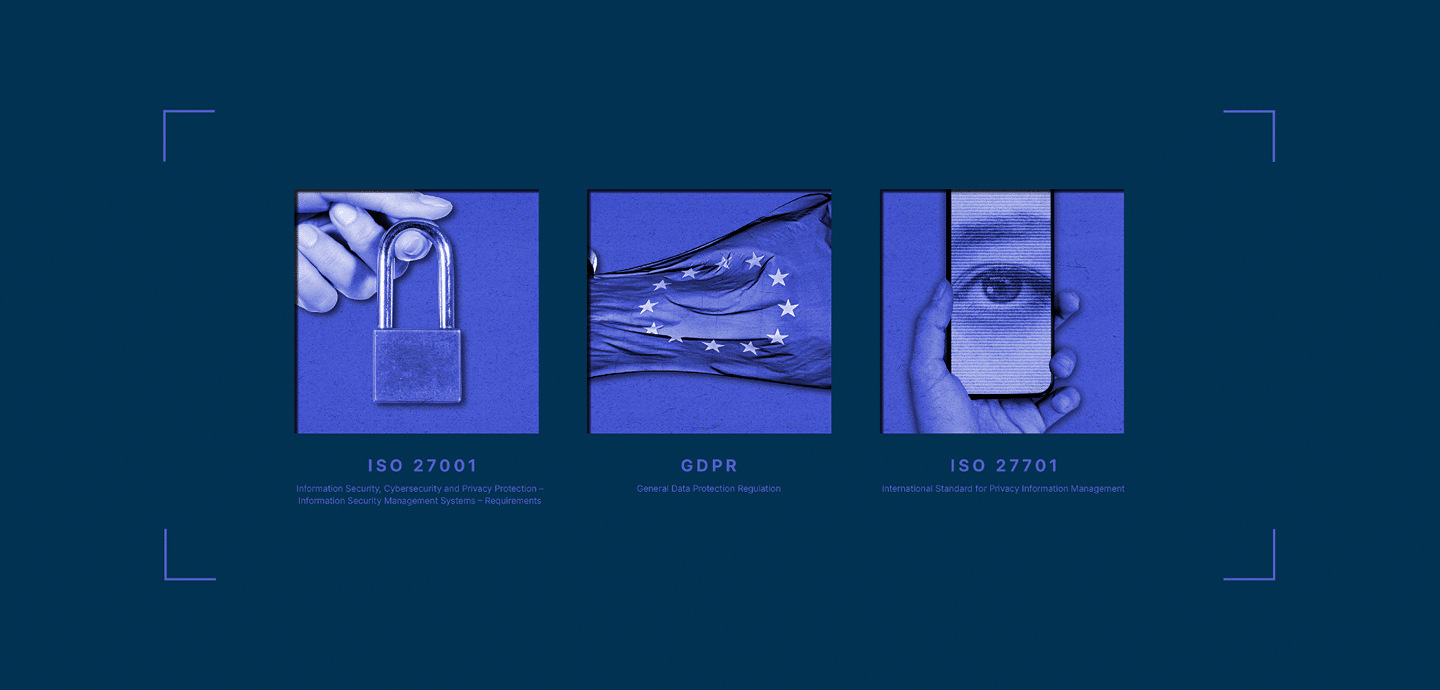
A Practical Guide to Data Protection Compliance: Understanding and Applying the GDPR Principles and Requirements
Table Of Contents:
Data protection has become a top priority for businesses and individuals. With complex regulations such as the General Data Protection Regulation (GDPR), navigating compliance can be challenging. In fact, over €359 million in significant GDPR fines have been issued so far. You must understand your obligations and comply with these regulations while protecting the privacy of your customers and employees.
And while many organisations claim to be prepared for data protection regulations, they may have yet to take all the measures needed to justify such claims.
According to a survey of 205 business leaders in the UK and US by law firm Womble Bond Dickinson, while many companies might implement external-facing actions, such as putting a cookie banner on their website or updating privacy policies, just 34% of all respondents say they have conducted data mapping and understand data practices across the organisation.
“Companies are often under-resourced and have to focus on cosmetic changes by updating public-facing content; however, this doesn’t eliminate the inevitable need to build out back-end requirements to truly operationalise the compliance requirements,” says Tara Cho, partner and chair of the Privacy and Cybersecurity Team for Womble Bond Dickinson (US).
So, how do organisations get through the maze of data protection regulations?
GDPR Principles and Compliance
The GDPR outlines seven vital data processing principles: lawfulness, fairness, transparency, purpose limitation, data minimisation, accuracy, storage limitation, security (integrity and confidentiality), and accountability. These principles form the core of an organisation’s data processing approach. Personal data must be collected and processed lawfully, fairly, and transparently. It should be obtained for specific, legitimate purposes and not used in incompatible ways. Data collected should be relevant, limited, and accurate. Steps must be taken to rectify inaccuracies promptly.
Data subjects’ information should be retained only as necessary for processing purposes. Security measures must be in place to guard against unauthorised processing, loss, or damage. Organisations must demonstrate compliance.
Apart from these principles, the GDPR covers various aspects, including special processing scenarios, data transfers, remedies, liability, and penalties.
According to Louise Brooks, Head of Consultancy at DQM GRC, the UK GDPR is principles-based, which means it doesn’t have a prescribed list of dos and don’ts.
“An organisation must consider the framework the UK GDPR provides and implement it as appropriate to the context of their business. We find that clients can struggle with this concept,” she says.
“It can also sometimes be difficult to establish a positive compliance culture that empowers organisations to make the right choices regarding data protection. We often find data protection viewed as a blocker, rather than an enabler, to business objectives. The right culture in an organisation will facilitate collaborative working and ensure data protection is the foundation upon which all business activities that involve personal data are based.”
Individual Rights
The GDPR provides several rights for individuals to help them control their personal data.
These rights include the right to be informed, the right to access, the right to rectification, the right to erasure (also known as the right to be forgotten), the right to restrict processing, the right to data portability, and the right to object.
Organisations must offer clear data details—what’s collected, usage, sharing. Individuals can request their processed data for accuracy and legality checks. Inaccuracies can be corrected. Data removal requests apply when unnecessary or consent is withdrawn.
Personal data usage can be restricted, e.g., contested accuracy or unlawful processing. Individuals can reuse their data, transferring it safely between organisations. Some data processes, like marketing, can be rejected. These rights amplify personal data control, promoting fairness and transparency.
Brooks says that when it comes to data subject rights requests, “an organisation should start by understanding which rights apply to which of its processing activities.”
“This is important because it will help organisations understand where the individual’s data is within the organisation, for example, in what systems, used by what teams, and what it is being used for, she adds.
Lawful Basis For Processing
The GDPR mandates valid legal grounds for processing personal data, encompassing six bases: consent, contract performance, legitimate interest, vital interest, legal requirement, and public interest.
Consent involves explicit permission for specific data processing, characterised by freedom, specificity, information, and clarity.
The performance of a contract necessitates data processing to fulfil or initiate a contract at an individual’s request.
Legitimate interest justifies data processing for organisational or third-party pursuits unless overridden by individual rights.
Vital interest entails data processing to safeguard an individual’s life or another’s.
Legal requirement demands data processing to comply with organisational legal obligations.
Public interest entails data processing for public task performance or official authority exercise.
Before processing personal data, organisations must determine and document their lawful basis. This basis is rooted in the GDPR or other relevant laws within the European Union or Member States.
Data Security
GDPR emphasises data security, mandating robust processing measures. These ensure protection against unauthorised processing, loss, and damage, utilising suitable technical and organisational steps.
Organisations consider risk analysis, policies, and physical/technical actions for data security. Measures assure data confidentiality, integrity, and timely recovery after incidents.
Examples: access controls, data loss prevention, encryption, incident response plans, third-party risk management, and physical/logical actions.
Regular review and testing are essential for effective security. Compliance fosters trust with stakeholders, building confidence.
Accountability and Governance
The accountability principle is one of the critical principles of the GDPR. Organisations must take responsibility for processing personal data and comply with other GDPR principles. This includes an obligation to demonstrate compliance through documented procedures and routines.
Organisations must be accountable for their data collection, processing, and storage activities and must be able to demonstrate that they have taken necessary measures to comply with GDPR obligations. This can be realised using suitable technical and organisational strategies. These strategies encompass;
- The adoption and execution of data protection policies
- Embracing the ‘data protection by design and default’ philosophy
- Establishing formal contracts with third-party entities handling personal data
- Upholding comprehensive records of processing activities
- Deploying adequate security protocols
- Documenting and communicating personal data breaches as needed
- Conducting assessments of data protection impact for situations involving substantial risks to individuals’ rights
- Designating a data protection officer when required
- Adhering to pertinent codes of conduct while also enrolling in certification programs.
Accountability obligations are ongoing, and organisations must review and update their measures at appropriate intervals. Implementing a privacy management framework can embed accountability measures and create a culture of privacy across an organisation. Accountability can help build trust with individuals and alleviate enforcement action.
International Data Transfers
GDPR covers personal data transfer to third countries or international organisations. Transfers outside the EEA are restricted unless protection or exceptions apply.
Data controllers and processors need an agreement with defined criteria under GDPR. Personal data transfer to countries without adequate protection requires “adequate safeguards,” ensuring enforceable rights and remedies for individuals.
Adequate safeguards can include mechanisms such as standard contractual clauses, binding corporate rules, or approved codes of conduct or certification mechanisms. In addition, several exceptions allow for transferring personal data outside the EEA without adequate safeguards, such as explicit consent from the individual, the performance of a contract, significant reasons of public interest, or the establishment, exercise, or defence of legal claims.
With the new EU-US data privacy framework coming in and some organisations moving away from standard contractual clauses (SCCs), it’s important to note that a new mechanism called a “data bridge” can be used to transfer personal data between the EU and the US. The UK and US have reached a commitment in principle to create a “data bridge” between the two countries. This mechanism would make it easier for around 55,000 UK businesses to transfer data freely to certified US organisations without cumbersome bureaucracy or regulations.
Organisations must ensure that they comply with the rules around international data transfers and use appropriate mechanisms to ensure compliance.
Exemptions
The GDPR has several exemptions that may apply in certain circumstances. These include exemptions for national security and law enforcement, certain types of personal data, journalism and creative expression, scientific or historical research, activities outside the scope of EU law, information not in a “filing” system, finance, management, and negotiations, public interest, and domestic use.
For example, the GDPR does not apply if an organisation doesn’t operate within the EU, doesn’t process personal data, or if it only processes data for domestic purposes. In addition, there are exemptions for processing personal data for journalistic purposes or for academic, artistic, or literary expression purposes.
Organisations must carefully consider whether any exemptions apply to their processing activities and must comply with all other requirements of the GDPR if no exemption applies.
ISO 27001 and GDPR Compliance
ISO 27001 is an international standard for an Information Security Management System (ISMS) that provides an excellent starting point for achieving the technical and operational requirements necessary to reduce the risk of a breach. The EU General Data Protection Regulation (GDPR) obliges organisations to implement applicable technical and organisational measures, including policies, procedures, and processes, to safeguard the personal data they process. Applying both standards will help you meet and demonstrate your compliance with the privacy and information security requirements of the GDPR.
Implementing an ISO 27001-aligned ISMS can help organisations achieve GDPR compliance cost-effectively by providing a framework for managing information security risks and demonstrating compliance with the GDPR’s technical and organisational requirements. By implementing both standards, organisations can ensure they meet the privacy and information security requirements of the GDPR and other data protection laws while minimising costs.
However, it has to be acknowledged that these standards do not cover all the aspects of GDPR, such as consent, data portability, the right to be forgotten, and international data transfers. Therefore, organisations must supplement their ISO frameworks with other measures to ensure full GDPR compliance.
Core GDPR Principles and Requirements to Achieve Success
Data protection regulations like GDPR may seem complex, but grasping core principles is vital. With this, organisations can ensure compliance and safeguard customer and staff privacy.
Remember these aspects:
- Grasp lawful data processing bases.
- Secure personal data.
- Uphold accountability.
- Obey international data transfer rules.
- Respect GDPR’s individual rights and exemptions.
Practical steps involve:
- Regular risk assessments.
- Robust security measures.
- Documented processing records.
- Clear communication with individuals.
- Consistent compliance updates.
By proactively complying, trust grows among stakeholders, minimising enforcement risks.




